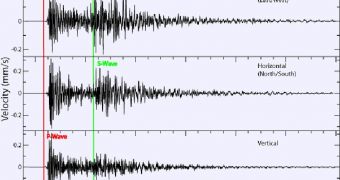Investigators at the Princeton University announce the creation of a new computer model that can be used to determine how seismic waves would affect the planet, were Earth to be hit by a meteorite.
Such a study could have important applications if a space rock were ever to be detected heading our way. Naturally, the conclusions would serve no purpose if the asteroid would have a diameter equal to the Moon's, but they could have practical uses if smaller meteorites impact the planet.
The new Princeton model is capable of simulating the seismic fallout of such an event, while at the same time using data of past collisions to reveal new information about the behavior of Earth's crust and mantle in such a scenario.
According to the research team, the new simulation takes into account a wide variety of factors when calculating the consequences of meteorite impacts, such as for example the elliptical shape of the planet, various features on its surface (such as mountains), and the depth of oceans in various places.
Until now, computer simulations were less complex in this regard, considering the planetary surface to be uniform, and only capable of the same type of response at different locations. As it stands, the vast Argentinian plains would respond differently to an impact than the Himalayas would.
Details of how the model combines all these aspects into a comprehensive view appear in the October issue of the esteemed Geophysical Journal International. The team also explains how the spread of seismic waves through the planet is emulated with the new system.
The investigation was led by Princeton Department of Geosciences Blair Professor of Geology Jeroen Tromp. He explains that the first event to be simulated was the collision that created the Chicxulub crater, in Mexico.
Previous studies at the location show that the explosion released the same energy as 2 million hydrogen bombs. It is widely believed today that this event was largely responsible for the disappearance of dinosaurs 65.5 million years ago, during the Cretaceous-Tertiary (K-T) extinction event.
“We have developed the first model to account for how Earth's surface features and shape would influence the spread of seismic activity following a meteorite impact,” lead study author and University of Munich investigator Matthias Meschede explains.
“For the Earth, these calculations are usually made using a smooth, perfect sphere model, but we found that the surface features of a planet or a moon have a huge effect on the aftershock a large meteorite will have, so it's extremely important to take those into account,” he adds.
“After a meteorite impact, seismic waves travel outward across the Earth's surface like after a stone is thrown in water. These waves travel all the way around the globe and meet in a single point on the opposite side from the impact known as the antipode,” the investigator explains.
“Our model shows that because the Earth is elliptical and its surface is heterogeneous those waves travel with different speeds in different areas, changing where the waves end up on the other side of the world and the waves' amplitude when they get there. These waves also are influenced by the interior,” Meschede concludes.
The US National Science Foundation (NSF) and the German Academic Exchange Service provided the funds needed to conduct the investigation.

 14 DAY TRIAL //
14 DAY TRIAL //